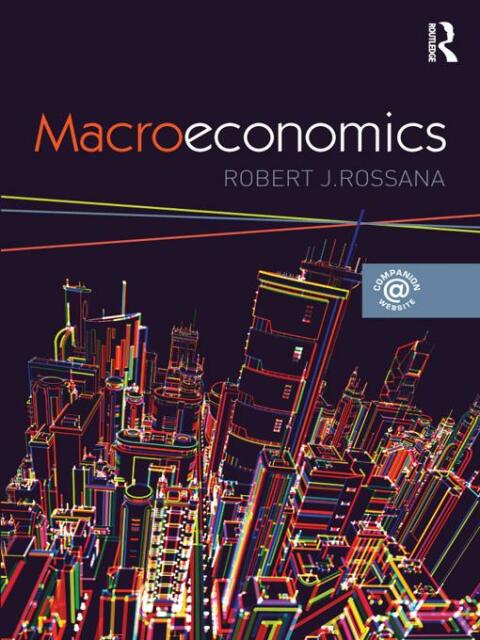Description
Efnisyfirlit
- Cover
- Title
- Copyright
- Contents
- List of “Doing Economics” Boxes
- List of Tables
- List of Figures
- Preface to the first edition
- Acknowledgments
- Part I Preliminary Topics
- 1 An Introduction to Macroeconomics
- 1.1 Methods of Analysis in Macroeconomics
- 1.2 What Macroeconomists Do: Building and Testing Models
- 1.3 Principles of Macroeconomic Analysis
- 1.4 Learning Macroeconomics
- 1.5 Chapter Organization
- 1.6 Questions for Study and Review
- Mathematical Appendix: Analytical Methods
- 2 Concepts and Measurement
- 2.1 National Income Accounting
- 2.2 Relationships Implied by NIPA Accounting
- 2.3 Essential Economic Concepts
- 2.4 Concluding Remarks
- 2.5 Questions for Study and Review
- Appendix: Compound Growth Rate Formulas
- 3 Business Cycle Measurement
- 3.1 The Business Cycle: A Definition
- 3.2 Properties of Macroeconomic Data
- 3.3 Serial Persistence and Comovement
- 3.4 Cyclical Indicators
- 3.5 Concluding Remarks
- 3.6 Questions for Study and Review
- Part II Microfoundations
- 4 Consumption
- 4.1 A Model of Household Behavior
- 4.2 How Consumption Responds to Changes in its Determinants
- 4.3 The Permanent Income Hypothesis
- 4.4 Ricardian Equivalence
- 4.5 A Simplified Consumption Model
- 4.6 Consumption and Saving Over the Life Cycle
- 4.7 Concluding Remarks
- 4.8 Questions for Study and Review
- 5 Investment
- 5.1 The Behavior of a Firm
- 5.2 Investment in Plant and Equipment
- 5.3 The Forward-Looking Nature of Investment
- 5.4 More on the User Cost of Capital
- 5.5 The Stock Market and Investment
- 5.6 Inventory Investment
- 5.7 Concluding Remarks
- 5.8 Questions for Study and Review
- 6 Government
- 6.1 The Role of Government
- 6.2 Government Expenditures and Tax Receipts
- 6.3 The Government Budget Constraint (GBC)
- 6.4 Financing Government Expenditures
- 6.5 Concluding Remarks
- 6.6 Questions for Study and Review
- 7 Money
- 7.1 Definitions and Uses of Money
- 7.2 The Demand for Money
- 7.3 The Supply of Money
- 7.4 The Money Market
- 7.5 The Velocity of Money
- 7.6 Concluding Remarks
- 7.7 Questions for Study and Review
- 8 The Labor Market
- 8.1 Labor Market Concepts and Data
- 8.2 The Demand for Labor
- 8.3 Labor Supply
- 8.4 The Market for Labor
- 8.5 Inflexible Real Wages
- 8.6 Concluding Remarks`
- 8.7 Questions for Study and Review
- Part III Aggregate Economic Models
- 9 Classical Models of the Aggregate Economy
- 9.1 Potential GDP
- 9.2 The Demand for Goods and the Classical Model of the Economy
- 9.3 Exercises Using the Classical Model
- 9.4 Intertemporal Productive Efficiency
- 9.5 Intertemporal Efficiency and Welfare
- 9.6 Economic Growth: An Introduction
- 9.7 Concluding Remarks
- 9.8 Questions for Study and Review
- 10 Economic Growth
- 10.1 Growth Accounting
- 10.2 The Solow Growth Model
- 10.3 The Empirical Implications of the Solow Model
- 10.4 Growth without Convergence
- 10.5 An Extended Solow Model
- 10.6 The Role of Government
- 10.7 Concluding Remarks
- 10.8 Questions for Study and Review
- Appendix: Deriving the Growth Accounting Formula
- 11 Aggregate Demand
- 11.1 The Goods Market
- 11.2 The Financial Market
- 11.3 Aggregate Demand
- 11.4 The Business Cycle: An Introduction
- 11.5 Concluding Remarks
- 11.6 Questions for Study and Review
- Appendix: Deriving the AD Schedule
- 12 The Business Cycle
- 12.1 The New Classical Model of Aggregate Supply
- 12.2 Shocks to Aggregate Supply
- 12.3 Keynesian Models of Aggregate Supply
- 12.4 Cyclical Fluctuations
- 12.5 Transitory Shocks to Aggregate Supply
- 12.6 Concluding Remarks
- 12.7 Questions for Study and Review
- Appendix: The New Classical and Keynesian Models of Aggregate Supply
- 13 Inflation, the Phillips Curve and Expectations
- 13.1 The Origin of Inflation
- 13.2 The Phillips Curve
- 13.3 The Phillips Curve and the AD-AS Model
- 13.4 Expectation Formation
- 13.5 Concluding Remarks
- 13.6 Questions for Study and Review
- Appendix: Forming a Rational Expectation
- 14 Macroeconomic Policy
- 14.1 Policy Goals
- 14.2 Issues Common to Monetary and Fiscal Policy
- 14.3 Monetary Policy
- 14.4 Fiscal Policy
- 14.5 Concluding Remarks
- 14.6 Questions for Study and Review
- Appendix: Policy Rules and the Aggregate Demand Schedule
- 15 The Open Economy
- 15.1 The Balance of Payments
- 15.2 The Market for Foreign Exchange
- 15.3 The Determinants of Nominal Exchange Rates
- 15.4 Open Economy Aggregate Models
- 15.5 The Open Economy IS Curve
- 15.6 The Open Economy Aggregate Demand Schedule
- 15.7 The Open Economy Macroeconomic Model
- 15.8 Concluding Remarks
- 15.9 Questions for Study and Review
- Appendix A: Uncovered Interest Parity
- Appendix B: The Open Economy Aggregate Demand Schedule
- Glossary
- Footnotes
- Index






